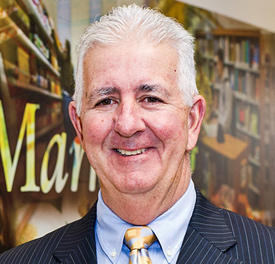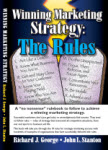Dr. Richard George is available to speak on a number of pertinent food marketing and customer service topics. For any of the topics below, Dr. George will customize his speech to meet the unique needs of your audience. If you would like a specific topic not covered below, please contact Dr. George.
Delightful Customer Service: 12 Steps to a Better Bottom Line
October 5 2015
Customer service is in a crisis mode. Consider the facts:
The American Customer Satisfaction Index stood at a barely passing grade (74) in its first year of measurement (1994). Today it is still in the low 70’s.
- 60% of so-called “satisfied” customers regularly switch companies or brands.
- Last year, over one quarter of a billion Americans stopped doing business with companies with which they were “satisfied.”
- The average company has 11% of its revenue at risk as a result of customer problems and how they are handled.
- $1 spent on advertising yields less than $5 in incremental revenue, but that same $1 spent on improving customer service can yield more than $60 in incremental revenue.
It doesn’t take Sherlock Holmes to discover the evidence of customer service that’s missed its mark:
- Clueless clerks roam the aisles of your supermarket or department store.
- Customer service reps themselves often need “anger management.”
- Customer service people answer questions with “I don’t know” or “that’s the policy.”
- Customer complaints are often either ignored or treated with disdain.
- Customer service hotlines that are simply not answered or which place the caller into an automated menu “black hole.”
Clearly, the efforts to date to improve customer service have failed. Previous rules and metaphors have done little to halt the flow of buyers wandering aimlessly in search of real relationships with sellers.
Everyone talks about customer service, but little is done to convert the rhetoric to reality. This presentation based on Dr. George’s latest edition of his book on customer service (Delightful Customer Service: 12 Steps to a Better Bottom Line), focuses on the concept of customer delight as a strategic marketing advantage. If you have suffered through countless books and presentations on customer service and are thoroughly confused, this practical presentation will discuss each of the 12 steps.
This interactive presentation highlights 18 worksheets, which help you to discover what it takes to delight your customers. These worksheets are designed for you to assess critically where your organization is relative to delighting customers. Also, completing appropriate worksheets will enable you to put the concepts you’ve learned into action with customer delight the result of your efforts. (Book Available)
Share This:
 RSS
RSS
Winning Marketing Strategy: The Rules
September 25 2015
This presentation focuses on successful marketers and explores their strategies for success. This lively, interactive session identifies ten universal rules for strategic success with countless clues. Participants can forever shelve their “ad hoc” approach to strategy and can take home an approach that can be implemented the next day. In essence, this approach to marketing strategy is comparable to a chess game. The secret is to out-think your competitor. Participants are reminded that it is not “history that repeats itself,” instead it is the “failure to learn from history that repeats itself.”
Some of the rules include the following: Rule 2: Know What’s Under Your Umbrella, Rule 4: Know Your Playing Field, Rule 5: Know Who You Are Playing Against. These rules and others are invaluable if you want to avoid an “ad hoc” approach to developing a winning marketing strategy. In particular, Rule 3: Get and Stay Close to the Customer, is the basis for my extensive research, writings, and presentations on customer service.
This interactive presentation is based on Dr. George’s latest marketing strategy book with same name. The presentation highlights several worksheets, which are designed for audience members to critically assess where their organizations are relative to developing a winning marketing strategy. Also, completing appropriate worksheets will enable you to put the rules you’ve learned into action. The result: delighted customers and increased profits.
Share This:
 RSS
RSS
Catch the Next Wave
August 5 2015
Everyone knows that the food retail environment is changing. Traditional food retailers are facing diminished profits and in many cases bankruptcy. On line food shopping and non-traditional food retailers like dollar stores and drug stores are taking share and profits. Consumers are seeking greater convenience, quicker check-out, friendlier service, more ethnic products, and now make their food purchases in a variety of non-traditional food retail outlets. As the expression says, “We can’t change the wind, but we can adjust our sails.” In addition, the environment confronting retailers is changing dramatically, from the exponential growth of mobile apps and payments, to the emerging of omni-channels, to the decline of the center of the store.
This interactive session will highlight several of these changes and will identify real opportunities for retailers to defend against or take advantage of these changes. Examples of simple, yet effective solutions to the changing environment and the needs of today’s consumers will be presented. In addition, session attendees will be invited to add their customized solutions. In effect, the session will act as a targeted share group.
Attendees will leave with easy to implement solutions which will allow them to catch the next wave and ride it successfully to the shore, avoiding rip currents, sands bars, etc. The goal of this session is not to make the attendees better educated food retailers. The goal is to make them better food retailers.
Share This:
 RSS
RSS
The Millennials: Food Retailing/Food Service Attitudes and Behaviors
July 19 2015
The Millennial generation can be roughly defined as the group of individuals born between the years 1981 and 1997 (oldest turn 35 in 2016). Called by several different names such as Generation Y, the Digital Generation, and Echo Boomers, this generation is one that is quickly establishing a strong identity as a consumer in today’s ever changing marketplace.Now, the largest generation (75.3 million) with an estimated spending power of $1.3 trillion/year. What generally do we know about this generation as it relates to food? Unfortunately, very little! Almost 4 in 10 agree with the statement, “The majority of companies don’t know how to market to my generation.”
This generation does not have the same attitudes/behaviors and will not spend on the same categories as their parents did. Food marketers who assume that the Millennials will start to behave like current older Americans, just because they age, do so at their peril.
This presentation will highlight the results of three research studies I conducted in 2009, 2012 and 2015. Included in the presentation will be food retailing shopping behaviors; activities for planning or doing grocery shopping; the impact of coupons, internet, etc. on food shopping purchases; foodservice behaviors; reasons for eating at a restaurant; and social media participation, usage and impact on food shopping and restaurant choice.
Attendees will be able to take home and put into effect immediately strategies and tactics to attract and maintain this group’s business. For example, recommendations on the use of social networks for recruiting and communicating store and restaurant offerings will be presented to address the needs of this “wired” generation as well as to enhance the your image among the Millennials.
The Millennials’ sheer numbers represent untapped potential if we can get them to perceive “your” brand, supermarket or restaurant as “their” brand, supermarket or restaurant! This presentation will help you to put down the water cannons and pick up the high pressure hose.
Share This:
 RSS
RSS
Winning Cutomer Rules
May 5 2015
Shopping may be Americans’ favorite pastime, but many shoppers don’t even know the rules of the game. Companies and their customers are both frustrated by the shopping process. For example, what’s the most important thing to know before you buy something? How reliable are brand names if you’re looking for quality? How can you get results when you complain about an item? Your answers can indicate whether you’re a skilled survivor in the shopping world, or whether you need a guide to rescue you. Sometimes the most expensive item may be the best for you, and at other times, the cheapest may work.
The people who play smart and win at the game of shopping know what they want, prepare properly, and follow through until they’re satisfied. This lively presentation, filled with lots of examples, details a seven-step approach that starts with knowing what you want and ends with making sure you got it. (Free Book Available) Learn how to become a smarter shopper and always get what you paid. This presentation is designed for today’s consumer. Get what you paid for & what you deserve with this presentation and free eBook – full of helpful websites & apps, game plans & tips on how to buy smarter.
Share This:
 RSS
RSS
Think Like a Brand, Act Like a Retailer
May 5 2009
Traditionally, retailers consider brands as those items on the shelf or on the rack that consumers come in their store to purchase. While this is true, it misses the concept of a brand and the importance of branding. Retailers have a tremendous opportunity to develop a differentiated brand but only if they realize that they are a brand. In fact, everyone is branding, whether we realize it or not. Branding is the sum of the good, the ugly, the on and the off-strategy actions that we take. It is defined by a finely worded CEO pronouncement as well as by every aloof employee and derisory consumer comment.
Brands are sponges for content, images, and fleeting feelings. Everything a company does create impressions, good or bad. If the branding process is not strategically focused the results may be catastrophic, even if the intentions are well-founded.
You cannot entirely control your brand. At best you can only guide and influence it. But how do you do that? During this lively, interactive presentation, Dr. George introduces 10 key branding concepts designed to insure that your retail operation is engaged in “an intimate dance with your customers.” The topics covered will include the concept of branding to leveraging the power of the retailer’s brand in an ever changing market.
Attendees will learn how to insure that the retailer’s targeted audience clearly recognizes its identity (beyond products on the shelves) and that the target market is able to clearly distinguish it from competing retailers.
Share This:
 RSS
RSS
Food Shopping: What is This Thing Called Customer Service?
May 5 2009
Typically, when asked about selecting a primary food retailer, customers tend to focus on non-customer service variables namely, cleanliness, quality, and price. However, whenever customers are asked “what improvements would you like to see in your primary grocery store?” the resounding reply is “better customer service.” However, the issue of what specifically constitutes better customer service has not been the focus of any known reported studies.
In essence, the three most mentioned factors (cleanliness, quality and price) are the “ante” to attract customers. Every food retailer, at a minimum, must offer these attributes. They are necessary, but not sufficient, to positively differentiate one food retailer versus another. However, the growth of food shopping alternatives in the form of super centers, club stores, chain drug stores, limited assortment and dollar stores, Internet, etc. have obviated the traditional food retailer’s cleanliness, quality, and price points of differentiation.
Results from a national research project will highlight the key customer service variables sought by consumers as well as an assessment on how well food retailers are performing on these variables. The study looks at all shoppers as well as perceptions by sex and age. Finally, the presentation will consider several strategic alternatives to adopt a customer service point of differentiation.
Share This:
 RSS
RSS
 RSS
RSS 



 by Richard J. George, Ph.D. (2021)
by Richard J. George, Ph.D. (2021)
 by Richard George & John Stanton
by Richard George & John Stanton